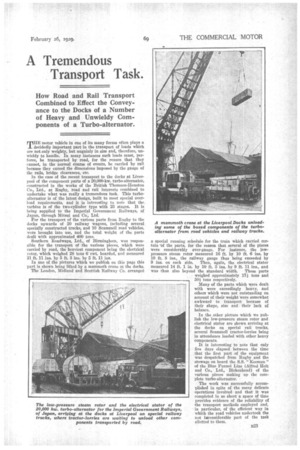A Tremendous Transport Task.
Page 49

If you've noticed an error in this article please click here to report it so we can fix it.
How Road and Rail Transport Combined to Effect the Conveyance to the Docks of a Number of Heavy and Unwieldy Components of a Turbo-alternator.
TEE motor vehicle in one of its many forms often plays a decidedly important part in the transport of loads which are not-only weighty, but ungainly in size and, therefore, unwieldy to handle. In many instances such loads must, perforce, be transported by road, for the reason that they cannot, in the normal course of events, be carried by rail because they exceed the dimensions imposed by the gauge of the rails, bridge clearances, etc.
In the case of the recent transport to the docks at Liverpool of the component parts of a 20,000-kw. turbo-alternator, constructed in the works of the British Thomson-Houston Co., Ltd., at Rugby, road and rail interests combined to undertake what was really a tremendous task. This turboalternator is of the latest design, built to meet special overload requirements, and it is interesting to note that the. turbine is of the two-cylinder type with 25 stages. It is being supplied to the Imperial Government Railways, of Japan, through Mitsui and Co., Ltd.
For the transport of the various parts from Rugby to the docks upwards of 20 railway wagons, including several specially constructed trucks, and 10 Scammelt road vehicles, were brought into use, and the total weight of the parts dealt with approximated 400 tons.
Southern Roadways, Ltd., of Birmingham, was responsible for the transport of the various pieces, which were carried by road, the heaviest component being the electrical rotor, which weighed 28 tons 6 cwt. boarded, and measured 21 ft. 11 ins. by 5 ft. 3 ins. by 5 ft. 11 ins.
In one of the pictures which we publish on this page this part is shown being lifted by a mammoth crane at the docks. The London, Midland and Scottish Railway Co. arranged
a special running schedule for the train which carried certain -of the parts, for the reason that several of the pieces were considerably over-gauge. For instance, the lowpressure steam rotor measured 16 ft. by 10 ft. 6 ins. by 10 ft. 8 ins., the railway gauge thus being exceeded by
9 ins, on each side. Then, again, the electrical stator measured 14 ft. 1 in. by 10 ft. 5 ins. by 9 ft. 11 ins., and was thus also beyond the standard width. These parts weighed approximately 17i tons and 50+ tons respectively.
Many of the parts which were dealt with were exceedingly heavy, and others which were not outstanding on account of their weight were somewhat awkward to transport because of their shape, size and their lack of balance.
In the .other picture which we publish the low-pressure steam rotor and electrical stator are shown arriving at the docks on special rail trucks, several Scammell tractor-lorries being in attendance loaded with other heavy components.
It is interesting to note that only five days elapsed between the time that the first part of the equipment was despatched from Rugby and the stowage on board the S.& " Keemun " of the Blue Funnel Line (Alfred Holt and Co., Ltd., Birkenhead) of the various pieces making up the complete turbo-alternator.
The work was successfully accomplished in spite of the many delicate operations involved and that it was completed in so short a space of time provides evidence of the reliability of the transport methods employed and, in particular, of the efficient way in which the road vehicles undertook the not ilsconsiderable part of the task allotted to them.




















































































































